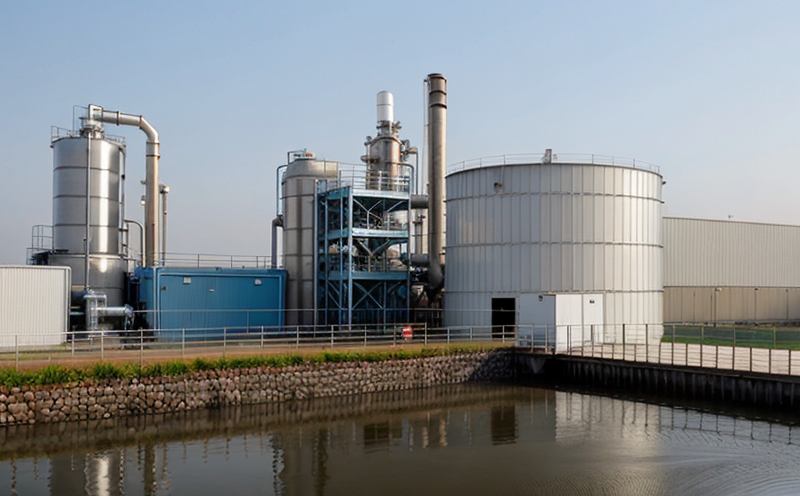ASTM D7573 Nitrogen Testing in Industrial Effluents
The ASTM D7573 standard provides a robust methodology for determining the total nitrogen content of industrial effluents, which is critical for environmental compliance and process optimization. This service focuses on quantifying ammonia (NH₃) and organic nitrogen compounds dissolved in water samples collected from various stages within processing facilities.
Industrial effluents often contain high levels of nitrogen due to wastewater discharge from manufacturing processes such as metal finishing, food processing, textile dyeing, and chemical production. Monitoring these nitrogen levels helps ensure that the facility adheres to local and international regulations regarding environmental impact mitigation. By accurately measuring ammonia and organic nitrogen using ASTM D7573, companies can identify potential sources of pollution, optimize waste treatment procedures, and improve overall water quality.
The test procedure outlined in ASTM D7573 involves several key steps: sampling, sample preservation (if necessary), digestion to convert all forms of nitrogen into ammonium ions, distillation or steam distillation to liberate the ammonia from the sample matrix, and finally titration using sodium thiosulfate solution to determine the amount of ammonia present. This multi-step approach ensures precise quantification even when dealing with complex mixtures typical of industrial effluents.
Our laboratory uses state-of-the-art instrumentation such as continuous flow analyzers equipped with pre-concentration columns and post-column derivatization units, which enhance sensitivity and reduce detection limits significantly compared to traditional manual methods. The use of these advanced tools guarantees reliable results that comply strictly with ASTM D7573 requirements.
Understanding the nitrogen content in industrial effluents is essential for several reasons:
- How does knowing the exact concentration help?Knowing the precise concentration allows facilities to fine-tune their treatment processes, reducing excess discharge and minimizing environmental harm.
- What challenges are associated with this type of testing?Challenges include ensuring proper preservation of samples during transport, accurate digestion of complex matrices, and interpreting results correctly given the variability in industrial effluents.
The accuracy and precision provided by ASTM D7573 nitrogen testing are vital for maintaining compliance with regulatory bodies like EPA, WHO, and other national standards. This service plays a crucial role in safeguarding our environment while supporting sustainable manufacturing practices.
| Parameter | Description |
|---|---|
| Total Nitrogen (TN) | The sum of all nitrogen species present in a sample. |
| Ammonia Nitrogen (NH₃-N) | The portion of total nitrogen that exists as ammonia. |
| Equipment Used | Description |
|---|---|
| Continuous Flow Analyzer | An advanced tool for simultaneous measurement of multiple analytes including nitrogen species. |
| Sodium Thiosulfate Solution | A reagent used in the titration step to determine ammonia content. |
Why It Matters
Monitoring nitrogen levels in industrial effluents is not just about meeting legal requirements; it also contributes significantly to improving operational efficiency and protecting ecosystems. Nitrogen-rich waters can lead to eutrophication, causing excessive growth of algae which depletes oxygen levels and harms aquatic life.
By implementing ASTM D7573 nitrogen testing, industries demonstrate their commitment to responsible stewardship. This service enables decision-makers to allocate resources effectively towards pollution prevention strategies, thereby enhancing brand reputation and fostering long-term sustainability goals.
Furthermore, compliance with these stringent standards ensures that businesses remain competitive in a global market where environmental responsibility is increasingly valued by consumers and stakeholders alike.
Scope and Methodology
The ASTM D7573 standard specifies the procedure for determining total nitrogen (TN) concentration in industrial effluents. This includes both ammonia nitrogen (NH₃-N) and other organic nitrogen compounds that can be converted into ammonium ions.
| Step | Description |
|---|---|
| Sampling | Select representative samples from different points along the wastewater stream. |
| Preservation (if needed) | Preserve samples by adding chemicals to prevent microbial activity or chemical changes until analysis. |
Digestion is performed using strong acids like nitric acid, which converts all forms of nitrogen into ammonium ions. Distillation then liberates the ammonia from the sample matrix for subsequent titration steps.
| Step | Description |
|---|---|
| Digestion | Convert all nitrogen species into ammonium ions through acid treatment. |
| Distillation | Liberate the ammonia from the matrix for further analysis. |
The final step involves titration using sodium thiosulfate solution, which reacts with excess silver ions formed during pre-reaction steps. The volume of titrant required correlates directly to the concentration of ammonia present in the sample.
Our laboratory adheres strictly to ASTM D7573 guidelines throughout every stage of the process, ensuring reliable and accurate results that meet or exceed international standards.
Competitive Advantage and Market Impact
Implementing ASTM D7573 nitrogen testing offers numerous competitive advantages for industrial facilities:
- How does this service enhance market competitiveness?By demonstrating a commitment to environmental protection, companies can gain an edge over competitors who may not adhere as closely to regulatory requirements.
Regulatory compliance is increasingly becoming a key factor influencing purchasing decisions among consumers and investors. Organizations that prioritize sustainable practices are likely to attract more favorable attention from these groups, leading to increased market share and improved profitability.
Moreover, early detection of potential issues through regular nitrogen testing can prevent costly fines and reputational damage associated with non-compliance. It also allows for proactive measures aimed at reducing operational costs related to wastewater treatment.
The demand for sustainable products and services continues to grow worldwide. Companies that invest in green technologies like ASTM D7573 compliant testing are better positioned to meet this trend, ensuring they remain relevant and viable players within their respective industries.





